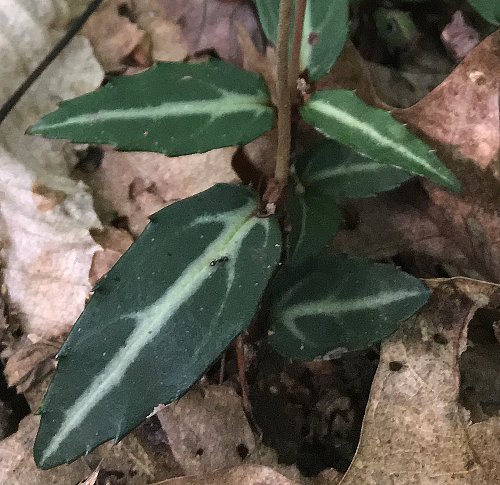
The blooming period occurs from late spring to early summer, lasting about 2 weeks. The flowers are fragrant. Afterwards, the flowers are replaced by seed capsules that are about 8 mm. (1/3") across and dark brown at maturity; they have the same shape as the ovary. The sepals persist underneath these seed capsules. When these capsules split open from above, they release many fine seeds. The root system consists of brown fibrous roots and underground white stolons; the latter are long and slender. Clonal plants are often produced from the stolons.
Cultivation: The preference is partial sun to medium shade, dry-mesic conditions, and an acidic soil containing some rocky material or sand. Growth and development are relatively slow. The seeds are difficult to germinate, although new plants can be created by dividing the root systems of older plants. In order to flourish, however, the presence of an appropriate mycorrhizal fungus in the soil may be required.
Range & Habitat: Striped Wintergreen is a rare native plant in Illinois, where it is state-listed as 'endangered.' It has been found in only two counties (Cook County and Pope County) within the state; see the Distribution Map. At the present time, it may be extirpated from Cook County because of development. Illinois lies along the NE range-limit of this plant; it is more common in mountainous areas further to the east and southeast. In Illinois, habitats consist of rocky upland woodlands and sandy upland woodlands; the latter habitat occurs along Lake Michigan. In these habitats, oaks (Quercus spp.) are usually the dominant canopy trees. Outside of Illinois, this plant is often found in mixed woodlands and coniferous woodlands. Striped Wintergreen is restricted to high quality natural areas in Illinois.

Faunal Associations: The flowers are cross-pollinated primarily by bumblebees; honeybees also visit the flowers (Standley et al., 1988). These insects obtain nectar from the flowers. The foliage of Striped Wintergreen is regarded as toxic to sheep (Schaffer, 1904), and White-tailed Deer usually avoid it when there are better sources of food (Rawinski, 2016).
Photographic Location: A wooded area in the southern Appalachian mountains. The photographs were taken by Paul Showers (Copyright © 2016).
Comments: Both the foliage and flowers are quite ornamental. In Illinois, the closest relative of Striped Wintergreen is Pipsissewa (Chimaphila umbellata). This latter plant can be distinguished by its leaves: 1) they are oblanceolate in shape, 2) the margins of its leaves are more finely and abundantly toothed, and 3) its leaves lack the white markings that are found on the leaves of Striped Wintergreen. The inflorescence of Pipsissewa also tends to have more flowers (4-8) than the inflorescence of Striped Wintergreen. The common name, 'Wintergreen,' refers to the evergreen leaves, as the leaves of Striped Wintergreen do not possess a mint-like fragrance. Thus, Striped Wintergreen should not be confused with another low-growing semi-woody plant, Wintergreen (Gaultheria procumbens). In addition to the fragrance of its leaves, this latter plant differs by its white bell-shaped flowers, red berries, and toothless leaf margins. Other common names of Chimaphila maculata are Spotted Wintergreen, Spotted Prince's Cone, Striped Prince's Cone, Spotted Pipsissewa, and Striped Pipsissewa.